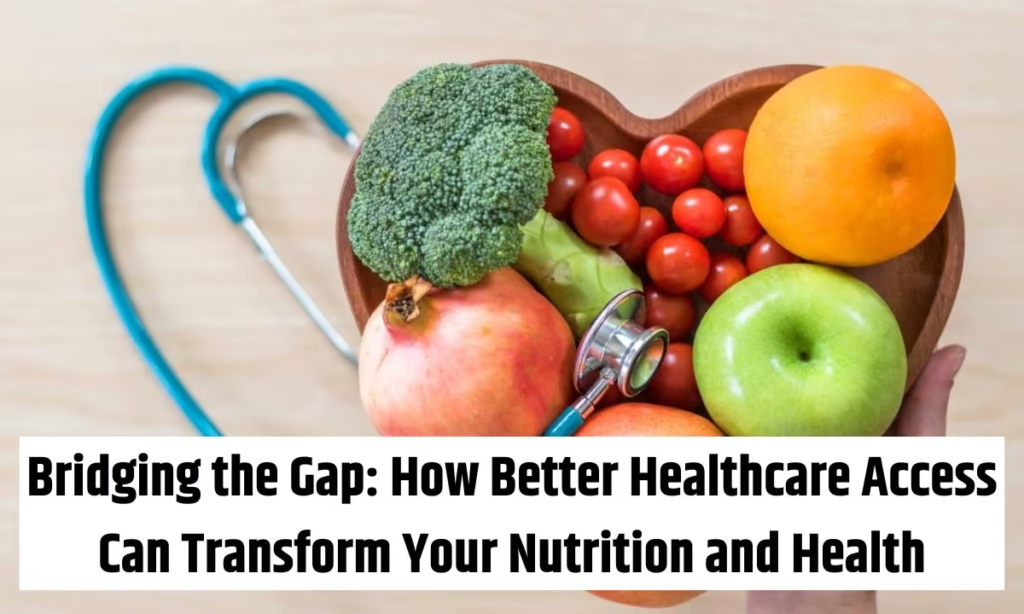Healthcare Access Can Transform Your Nutrition and Health: In a world where fast food is just a click away and medical appointments can feel like a luxury, the connection between healthcare access and nutrition often gets overlooked. Yet, imagine this: nearly half of all deaths in children under five worldwide are linked to poor nutrition, and limited healthcare only makes it worse. This isn’t just a statistic—it’s a reality for millions struggling to stay healthy.
As we dive into the topic of healthcare access and nutrition, we’ll explore how these two pillars of well-being are intertwined, the challenges people face, and practical ways to overcome them. Whether you’re a busy parent, a health enthusiast, or someone looking to make smarter choices, this guide will equip you with insights to improve your life and those around you.
What Is Healthcare Access?
Healthcare access refers to the ability of individuals to obtain timely, affordable, and quality medical services. It’s not just about having a doctor nearby; it includes everything from preventive check-ups to emergency care and ongoing support for chronic conditions. In many parts of the world, especially in low-income areas, access is limited by factors like geography, cost, and availability of professionals.
Think about it: if you can’t see a doctor regularly, how do you get advice on managing diabetes or heart disease? Without access, people miss out on essential screenings, vaccinations, and education that could prevent health issues. Globally, about 7% of adults skip needed medical care due to costs, leading to untreated conditions that spiral into bigger problems. Good access means equitable services for all, regardless of income or location, and it’s a foundation for overall health.
The Power of Good Nutrition
Nutrition is the fuel that powers our bodies, influencing everything from energy levels to disease resistance. A balanced diet rich in fruits, vegetables, whole grains, lean proteins, and healthy fats provides the vitamins, minerals, and nutrients needed for optimal function. For instance, adequate intake of calcium and vitamin D strengthens bones, while omega-3 fatty acids support heart health.
The benefits are profound. Eating well can reduce the risk of chronic diseases like obesity, type 2 diabetes, and cardiovascular issues by up to 80% in some cases. It boosts immunity, helping your body fight off infections, and even enhances mental health by stabilizing mood and improving cognitive function. In children, proper nutrition supports growth and development, preventing issues like stunting, which affects around 21% of kids under five globally.
But nutrition isn’t one-size-fits-all. Cultural preferences, age, and health conditions play a role. For example, pregnant women need more folic acid to prevent birth defects, while older adults benefit from protein to maintain muscle mass. The key is variety and moderation—swapping sugary drinks for water or processed snacks for fresh produce can make a big difference.
How Healthcare Access and Nutrition Connect
Healthcare access and nutrition are like two sides of the same coin; one directly impacts the other. When people have reliable healthcare, they receive personalized nutrition advice from doctors, dietitians, or nurses. This might include meal plans for managing weight or dietary adjustments for allergies. Without access, individuals rely on guesswork or unreliable sources, leading to poor choices.
Consider the cycle: Poor nutrition weakens the immune system, increasing illness and the need for medical care. But if healthcare is inaccessible, illnesses go untreated, worsening nutrition through loss of appetite or inability to afford healthy foods. Studies show that food-insecure households—those without consistent access to nutritious meals—incur higher medical costs, sometimes up to 25% more annually.
In underserved communities, this link is stark. Limited clinics mean fewer nutrition education programs, resulting in higher rates of malnutrition. Conversely, integrated healthcare systems that include nutrition counseling see better outcomes, like reduced hospital readmissions and improved quality of life. Programs that combine medical check-ups with food assistance demonstrate how addressing both can break the vicious cycle.
Common Barriers to Healthcare Access and Nutrition
Despite the clear benefits, many face hurdles in accessing healthcare and maintaining good nutrition. One major barrier is cost. Medical visits, prescriptions, and healthy foods can be expensive. In urban poor areas, families might choose cheaper, calorie-dense options over nutrient-rich ones, leading to obesity and related health issues.
Transportation is another issue. Rural residents often travel long distances to see a doctor or buy fresh produce, deterring regular care. Long waiting times at facilities, staff shortages, and drug stockouts add frustration. In some regions, cultural or language barriers prevent effective communication, leaving patients without tailored nutrition guidance.
Social factors play a role too. Structural issues like neighborhood segregation limit access to grocery stores with healthy options, creating “food deserts.” Social media trends promote fad diets that confuse people, while lack of education means many don’t know how to read nutrition labels. For children with special needs, these barriers amplify, as specialized nutrition services are scarce.
Globally, malnutrition affects over 149 million children with stunting, often due to inaccessible healthcare in low-income countries. Even in wealthier nations, about 10% of families struggle with food insecurity, linking directly to poorer health outcomes.
Strategies to Improve Healthcare Access and Nutrition
The good news? There are actionable ways to bridge these gaps. Start with policy changes: Governments can expand insurance coverage to include nutrition counseling and subsidize healthy foods. Community programs, like mobile clinics, bring services to remote areas, offering check-ups and diet education on the spot.
On a personal level, small habits count. Base meals on fiber-rich carbs like brown rice or oats for sustained energy. Aim for at least five servings of fruits and veggies daily—think colorful salads or smoothies. Choose whole grains over refined ones, and opt for low-fat dairy or plant-based alternatives. Limit sugary drinks; water or herbal teas are better.
Exercise complements nutrition; pair healthy eating with 30 minutes of activity daily to boost metabolism. Track progress with apps that monitor intake and suggest balanced recipes. For families, involve kids in cooking to build lifelong habits.
Healthcare providers can integrate nutrition into routine visits. Telehealth has revolutionized access, allowing virtual consultations for diet advice without travel. Programs like food prescription initiatives, where doctors “prescribe” healthy groceries, have shown promise in reducing chronic disease risks.
Communities can advocate for better infrastructure, like farmers’ markets in underserved areas or school nutrition education. Non-profits often run workshops on budget-friendly healthy cooking, empowering people to make informed choices.
Real-World Examples of Success
Looking at successful initiatives inspires action. In India, the Integrated Child Development Scheme provides supplementary nutrition and health check-ups to millions of children and mothers, significantly reducing undernutrition rates in participating areas. Another example is a U.S. hospital program that partners with local farms to deliver fresh produce to patients with diabetes, leading to better blood sugar control and fewer hospital visits.
In Africa, community health workers trained in nutrition deliver doorstep services in rural villages, combining vaccinations with feeding advice. This has cut child malnutrition by notable percentages in pilot regions. Telehealth nutrition services in outpatient settings allow dietitians to reach more people, especially during pandemics, improving adherence to healthy eating plans.
School-based programs in various countries offer free balanced meals and health screenings, resulting in better academic performance and lower obesity rates. These examples show that targeted, collaborative efforts can yield measurable improvements in health outcomes.
Conclusion
Healthcare access and nutrition are essential for a thriving society, yet gaps persist that affect millions. By understanding their connection, recognizing barriers, and adopting practical strategies, we can foster better health for ourselves and our communities. From personal habits like mindful eating to broader changes like policy advocacy, every step counts.
Remember, health isn’t just about avoiding illness—it’s about living vibrantly. Take charge today: schedule that check-up, try a new healthy recipe, or share this knowledge with someone who needs it. Together, we can bridge the gap and unlock a healthier future. Your body will thank you!
FAQ about Healthcare Access Can Transform Your Nutrition and Health
What is the main link between healthcare access and nutrition?
The link is that good healthcare provides education and support for better eating habits, while poor access leads to unmanaged health issues that affect appetite and food choices.
How does poor nutrition impact healthcare needs?
Poor nutrition increases the risk of diseases like diabetes and heart problems, leading to more frequent and costly medical interventions.
What are simple ways to improve my nutrition at home?
Start by adding more fruits and vegetables to meals, choosing whole foods over processed ones, and staying hydrated. Consult a healthcare provider for personalized tips.
Why is healthcare access worse in some areas?
Factors like poverty, remote locations, and lack of infrastructure contribute. Urban areas might have “food deserts” with limited healthy options.
Can programs like food assistance really help?
Yes, initiatives like SNAP have been linked to lower medical costs and better health, proving that combining nutrition support with healthcare works.
How can I advocate for better access in my community?
Join local health groups, support policies for expanded services, and participate in community gardens or nutrition workshops.

